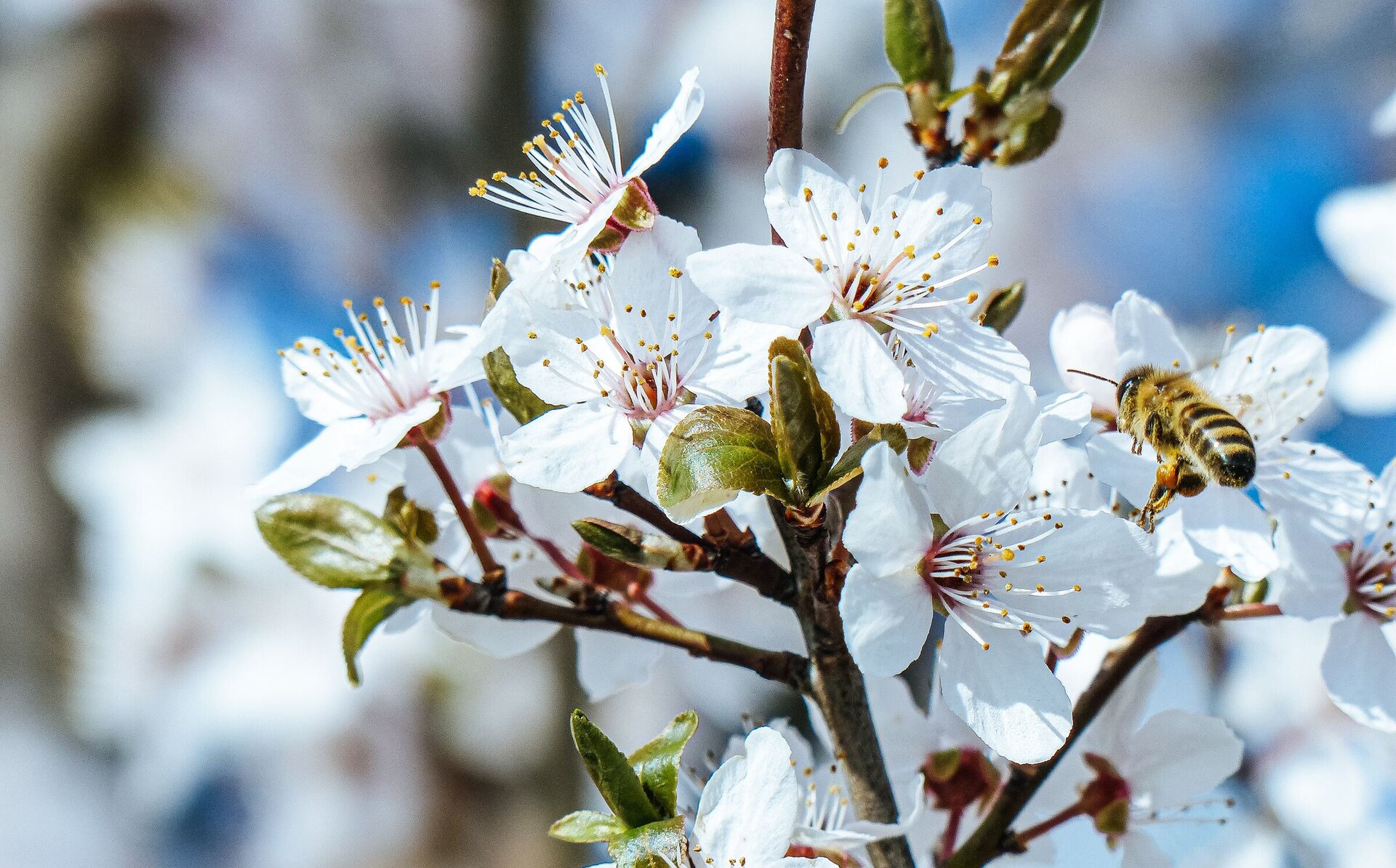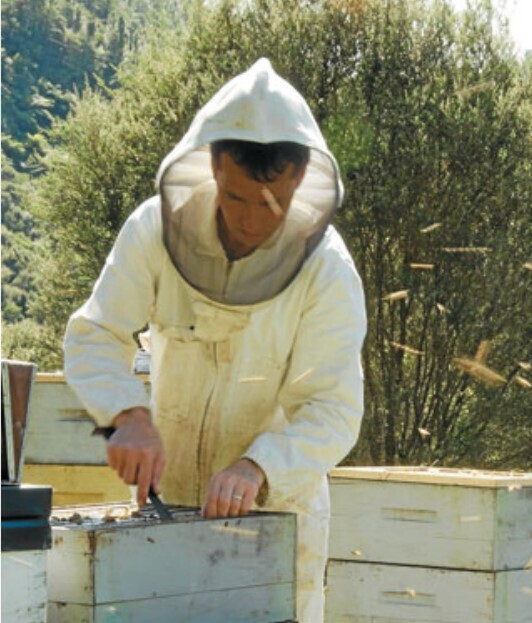Martin Lynch can remember being fascinated with bees as a young child. That childhood fascination, inspired by his father, blossomed into a much-enjoyed hobby and he set up his first lot of beehives in his early teens, eventually inheriting his father’s bees from the family home in Ohinewai.
Although he went on to train as an engineer, leading into a role as a corporate consultant, Martin’s early passion for bees remained. A self-confessed keen hobbyist, more recently his love for bees has evolved into a thriving business; Sweetree Honey.
Having largely swapped his tailored suits for a beekeepers kit, Martin now spends almost half of his working week tending his 100 beehives, set among native New Zealand bush around the greater Waikato region.
Sweetree Honey has rapidly gained a loyal following among those who appreciate the subtleties of artisan produced honey and its wonderfully diverse flavours, including caramel, butter and even hints of pepper.
With 100 beehives spread over five locations, Martin keeps his honey pure and doesn’t blend the honey from different sites. That allows the characteristics of each apiary location to shine through - from Marokopa Valley on the west coast of the north island, to the Four Brothers Reserve, from a site between Hamilton and Raglan.
With his wife Stephanie, and sons Daniel (9) and Matthew (7) also keenly involved in Sweetree Honey, this is a family business in every sense. Martin is predominantly responsible for the hives with Stephanie involved in packaging, marketing and the hundreds of tasks in between. The boys have their own beekeeping suits and are remarkably confident around the bees.
The Journey
The Sweetree Honey journey began after the couple moved their Hamilton lifestyle block (complete with Martin’s three beehives) and set about researching what to do with their four hectare property, overlooking Waikato River.
“In the end we decided to lease out part of the property to a neighbour for his stock and focus on actively managing the bees so we could gain some useful income.
“We started off about four years ago, gradually increasing our hive numbers to about 40 hives,” says Martin, “and focused on collecting bee pollen, which we sold directly to Comvita.”
The arrival of new neighours; James and Miriam Driscoll, stepped up the beekeeping operation. A fellow bee enthusiast, James had kept a few hives and had many years’ experience in the industry. The quartet decided to join forces and extend the operation, starting a small commercial beekeeping business called Vitality Bee Products Ltd.
Specialising in bee pollen (which is globally recognised as an incredible natural source of nutrients, vitamins and minerals), Martin and James handled the practical side (the bees and beehives), with Stephanie and Miriam focusing on the business and product development.
Number increased to about 100 hives and demand for Vitality bee pollen continued growing.
Hamilton Farmer’s Market was the original testing ground and the initial crop of bee pollen and pasture honey proved so popular that the team were justified in their belief that there was a market for quality artisan produce.
However, busy lives intervened, and with James and Miriam pursuing other ventures, Martin and Stephanie purchased their share of the business.
“We’re still really good friends, but it was growing to the extent that we were all struggling to juggle the honey business as well as our other commitments.”
Martin made the decision to leave his full-time corporate role and start his own consultancy business. This gave him the flexibility to spend more time with the beehives.
Sweetree
A key factor was having access to a farm with plenty of native bush and manuka. The opportunity to put hives at Marokopa Station, a large hill country farm on the outskirts of the small remote seaside settlement of Marokopa (an hour out of Waitomo), was crucial.
The farm borders the Marokopa River, where cattle and sheep are farmed on the river plains and surrounding steep hills. Unspoilt native bush covers large areas of the hilltops, where the beehives are sited. The pristine environment is key to creating superb honey.
“Originally, we planned to sell the honey in bulk but we had it tested and it was so good, that we thought we would try to sell it ourselves.” And so began Sweetree Honey.
“I think because our honey has such a unique flavour that it really appeals. I love the fact the flavour reflects the area it is from so strongly which is why we don’t blend our honey.”
Much like great wine reflects its origins, Sweetree Honey is a true taste of Waikato’s distinctive flora and fauna. The Marokopa honey is alive with flavours of manuka, rewarewa and heketara, while the Four Brothers Reserve boasts an almost caramel flavour.
“We call our honey raw honey, really to let our customers know that we have taken care to keep any heating to a minimum, thereby ensuring the honey’s natural enzymes, goodness and flavour is not degrading during extraction and packing into jars. Our customers repeatedly tell us how it tastes like the honey they remember from their childhood.
“Our aim is to ensure that the goodness from the bees ends up on the plate.”
What Goes Around Comes Around
Martin and Stephanie’s involvement in local farmer’s markets inspires them on their quest towards self sustainability.
“We’re exposed to all of these amazing local hobbyists and businesses, growing, harvesting and developing their own produce. It’s pretty fantastic and we have greatly reduced our spend at the supermarket,” Martin said.
“It’s exciting knowing that you are eating local produce and seasonal food.”
The couple’s own thriving vegetable garden is supplemented by a flock of free-range chickens and a few sheep.
Steph is a lifelong foodie and utilises honey (of course) in many of her recipes. She has a strong interest in traditional foods and enjoys working with ingredients as close to their raw state as possible. Spelt flour and any ingredients with natural goodness frequently feature in family meals.
“We love being part of this circle of people who are passionate about food and natural ingredients,” she said.
Working Bee
While the end result is undeniably glorious, keeping his millions of bees in optimum health is more than just luck. Each of the Sweetree hives produce honey harvests of between 20-60kg of honey annually. However, not all the honey is taken off, as Martin believes it is very important to ensure sufficient stores kept as winter food for the bees.
“It’s healthier for the bees to eat their own honey and pollen during winter, rather than supplement their diet with sugar syrup. I think it also makes the bees less susceptible to parasites, viruses and illnesses,” Martin said.
There’s something of the worker bee about Martin. He is determined to produce the best honey he can, by keeping his bees in top condition and knowing exactly what goes into and comes out of each individual hive.
“One of the most challenging aspects is managing your time effectively. You have to put in a lot of effort initially to get systems working properly so you can do things efficiently,” he said.
Despite the hours Martin spends working with bees, he always gets kitted up in his beekeepers gear.
“I’ve been stung more than the average person, of course, and it doesn’t bother me much and I always look to work calmly and quietly around the bees. However when you start to manage larger number of bees, you can’t always wait for ideal conditions. You have to get on with it. “You do get a little bit immune to stings but the level of pain does vary from bee to bee. Not all bee stings are the same!” While the demand is there, Martin is reluctant to grow his business too much, preferring to keep tight quality control so he knows every ounce of honey in the jar is from his own healthy hives.
“We’re at the stage now where demand exceeds supply, so we will gently grow our hives to about 150. However, if it gets too large it becomes a commercial entity and I don’t know that we could keep delivering the same quality in that case, so I’m very happy with how things are at the moment.” With the size restriction comes some boundaries.
“For the number of hives we have, it’s not cost effective to have our own equipment, so we get our honey extracted in Hamilton at Hillcrest Apiaries. The beauty of this is that it is done locally, by people we know and trust.” All photos © Claudia Aalderink.
Sweetree
Honey Unblended honeys are not new, but the fact that Sweetree honey is not based on a single flower source, but on the local area and season, makes it something special. Sweetree honey is raw honey, which retains all of the natural goodness associated with honey. The natural enzymes present in the honey are preserved during processing, so you end up with a product that is exactly as it was in the hive.
Bee pollen
Collected by honey bees, bee pollen is tiny nuggets of golden goodness. As the bee moves from one flower to the next, it places flakes of pollen on to pollen baskets on its back legs. These flakes are combined with nectar to make a granule of bee pollen. An incredible natural source of nutrients, vitamins and minerals, studies have shown that bee pollen has a nutritional composition which surpasses virtually any other food. Sweetree bee pollen is collected from the home apiary site at Horsham Downs, near Hamilton. With abundant nearby flora, Sweetree honey bees gather pollen from a wide range of flowering plants, reflected in the many different colours of pollen.
Beeswax
Beeswax is a remarkable by product of honey. Made by the youngest honey bees in a colony, which are too young to forage for nectar. To produce the wax, they gorge themselves on honey and link themselves together by the hundreds. After several hours, wax starts to flow from pockets in their abdomens. Each bee then scrapes off the wax with their legs and chews it into soft pellets. They then use these pellets to make perfectly engineered honeycomb cells. The hexagon shape used is the most efficient storage structure ever developed by any species, including humans.
How to Eat Sweetree Bee Pollen
Bee pollen can be added to a wide variety of food; from sprinkle it on your breakfast cereal to adding to yoghurt, smoothies or ice-cream. The flavour of the bee pollen will depend on the floral source, and each granule has a different flavour. Expect to receive a mouthful of many flavours, including sweet, tarty and earthy.
Bee Pollen ideas:
- Add bee pollen to a dish of ice cream and hot chocolate sauce.
- Place bee pollen onto a piece of tin foil then take a peeled banana and roll it into the bee pollen and toasted coconut.
- Add a tablespoon of bee pollen to beef casseroles or beef stir-fries.
- Add bee pollen to salsa, homemade salad dressing and sandwiches .
- Spread it on toast with honey.
- Mix bee pollen, chai seeds and cinnamon together with mashed banana and yoghurt (any flavour) and spread on raisin toast for a yummy breakfast.
- If you are not that fussed on the flavour, you can simply take it in a spoon and chase with water or juice. People who have severe allergies should be cautious using bee pollen as it many cause an allergic reaction. Anyone uncertain if they are allergic to bee pollen should talk to a health professional or have an allergy test.
Originally published in NZ Lifestyle Magazine Waikato Times, June 2012.







